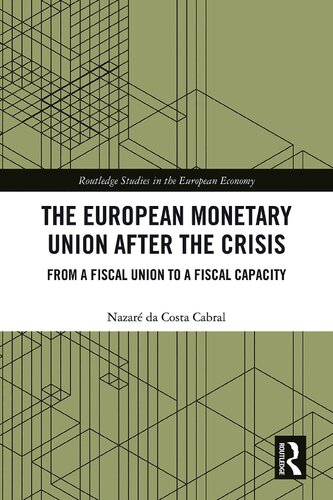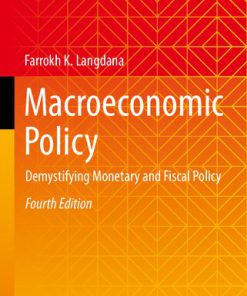The European Monetary Union After the Crisis From a Fiscal Union to Fiscal Capacity 1st Edition by Nazare Da Costa Cabral ISBN 1000096564 9781000096569
$50.00 Original price was: $50.00.$25.00Current price is: $25.00.
The European Monetary Union After the Crisis From a Fiscal Union to Fiscal Capacity 1st Edition by Nazare Da Costa Cabral – Ebook PDF Instant Download/Delivery: 1000096564, 9781000096569
Full dowload The European Monetary Union After the Crisis From a Fiscal Union to Fiscal Capacity 1st Edition after payment

Product details:
ISBN 10: 1000096564
ISBN 13: 9781000096569
Author: Nazaré da Costa Cabral
This book provides a much-needed detailed analysis of the evolution of Europe over the last decade, as well as a discussion about the path of reform that has been trodden in the aftermath of the financial crisis. It offers a multidisciplinary view of the E(M)U and captures the main factors that induced the reform of the monetary union – a process that has not been linear and is far from being concluded. The author examines the policy responses designed throughout the development of the crisis and assesses the scale of the crisis in Europe, in comparison to other parts of the world, as well as its prolonged effects both in economic and financial terms. An update on the current ‘state of the art’ in the conception of risk-sharing mechanisms is provided. With its innovative approach, the book analyses the financing issues which need to be taken into consideration in the design of these instruments and highlights the main categories of governmental risk-sharing mechanisms – in particular, the ones to be used as ‘fiscal capacity’. This is a timely and topical book and will be of interest to a broad audience, including experts, scholars and students of European affairs, particularly those with economic, financial, legal and political science backgrounds.
The European Monetary Union After the Crisis From a Fiscal Union to Fiscal Capacity 1st Table of contents:
1 Introduction
1.1. The Great Financial Crisis as a global and systemic crisis
1.2. The GFC, hysteresis and secular stagnation
1.3. The metamorphosis of the crisis in Europe, misguiding policy signs and the EMU’s vulnerability
1.4. Monetary policy exhaustion, economic slowdown and ‘foggy’ times in Europe
1.5. A new policy agenda for the EMU: risk-sharing mechanisms as a panacea to save the euro
PART I The Great Financial Crisis and the Economic and Monetary Union
2 From the financial crisis to the euro crisis
2.1. The ‘twin and triple crisis’ theoretical framework
2.1.1. Twin and triple crisis
2.1.2. Twin crises and capital flows
2.2. Metamorphosis of the crisis in the EMU: from the financial crisis to the euro crisis
2.2.1. Causal events that determined the mutation of the crisis
2.2.1.1. An outstanding event: the EMU crisis as an extension/expression of the subprime bubble
2.2.1.2. The immediate trigger: the revelation of the Greek deficit in 2009
2.2.1.3. The causal complexity of the metamorphosis of the crisis
2.2.2. The cascade effects driven by metamorphosis of the crisis
2.2.2.1. ‘Doom looping’ between sovereign debt and bank debt; bailouts to the banking sector; bank debt nationalization issue
2.2.2.1.1. ‘Doom looping’ between sovereign debt and bank debt
2.2.2.1.2. Government bailout of the (domestic) banking sector
2.2.2.1.3. Bank exposure to sovereign debt (nationalization of the bank debt)
2.2.2.2. Fiscal effects of the crisis
2.2.2.3. The euro crisis and the fragmentation of the financial markets
2.3. The euro area crisis as a balance-to-payments and a currency crisis
3 Misguiding signs in the policy responses to the EMU crisis
3.1. From market forces to public action
3.2. From fiscal stimulus to austerity; the magnitude of fiscal multipliers
3.2.1. The initial response: fiscal stimulus – the ‘European Economic Recovery Plan’ (EERP)
3.2.2. The magnitude of fiscal multipliers: results of investigations regarding the ARRA
3.2.3. The enthronement of austerity and the ordoliberal justification
3.2.4. Economic reasoning for austerity
3.2.4.1. Expansionist fiscal adjustment
3.2.4.2. The relationship between (high) debt and economic growth
3.2.5. Austerity and the assistance programmes to peripheral countries
3.2.6. The multiple dimensions of austerity: from fiscal adjustment to structural reforms
3.3. From the non-bailout clause to quantitative easing: the monetary policy during the crisis
3.3.1. The non-bailout clause in the TFEU
3.3.2. Central banks’ intervention to rescue the banking sector: the ‘lender-of-last-resort’ function
3.3.3. The ECB’s non-conventional monetary policy; credit easing versus quantitative easing
3.3.4. The effects of the APP
3.3.4.1. The effectiveness of the APP
3.3.4.2. The APP and the transmission mechanism of the monetary policy
3.3.5. ECB’s monetary policy and the role of the Court of Justice of the EU
3.3.6. The normalization of monetary policy?
PART II Governmental risk-sharing mechanisms after the crisis: from a fiscal union to a fiscal capacity
4 The ‘EMU’s great reform’ as an imperative
4.1. The evolution of the (mainstream) discourse about the crisis over the years: from national failures to E(M)U flaws
4.1.1. Introduction: from national failures to E(M)U failures
4.1.2. EMU failures in the tests for optimality; decentralization versus centralization of fiscal policy
4.1.2.1. Introductory remarks: a currency area as an exacerbation of a fixed exchange rate system
4.1.2.2. EMU failures in the tests for optimality
4.1.2.3. Decentralization versus centralization of fiscal policy; EMU atypical solution
4.1.3. E(M)U as a lopsided fiscal union
4.1.3.1. A review of Fiscal Federalism literature
4.1.3.2. Normative criteria for functions and revenues assignment: the two steps of Fiscal Federalism theory
4.1.3.2.1. Functions assignment
4.1.3.2.2. Revenues assignment
4.1.3.3. Initial attempts to transpose the Fiscal Federalism framework to European integration
4.1.3.4. General and specific limitations in the transposition of the main prescriptions of Fiscal Federalism
4.1.3.4.1. General limitations: E(M)U ambiguities
4.1.3.4.2. Specific limitations in the transposition to the EU of Fiscal Federalism prescriptions
4.2. Catalogue of proposals for the ‘Great EMU’s Reform’: roadmaps or crossroads?
5 Risk-sharing mechanisms as a panacea for saving the euro: a fiscal capacity for the EMU
5.1. Basic conceptual elements of the notion of ‘risk sharing’; a first justification for governmental risk-sharing mechanisms
5.1.1. Consumption smoothing versus international risk sharing; private versus governmental risk-sharing instruments
5.1.2. Refining the notion of (governmental) risk sharing: types of shocks; stabilization lato sensu versus insurance
5.1.3. First generation of proposals for the creation of insurance devices at the European level
5.1.3.1. Analysis of the level of insurance in preexisting fiscal federal experiences
5.1.3.2. Seminal proposals for the creation of insurance devices at the European level: main conceptual elements
5.1.3.2.1. The first conceptual element is the type of shock
5.1.3.2.2. The second conceptual element is the nature of the insurance mechanism
5.1.3.2.3. The third conceptual element relies precisely on the identification of the trigger and on the automaticity of the scheme
5.1.3.2.4. The fourth conceptual element relates to the instruments aiming at preventing and correcting moral hazard (and possible adverse selection)
5.2. From a full-fledged fiscal union to a fiscal capacity in the EMU
5.2.1. The design of the fiscal capacity
5.2.1.1. Justification for creating a fiscal capacity
5.2.1.2. Financing issues of the fiscal capacity
5.2.1.2.1. Tax assignment: the EU ‘own resources system’ and future prospects
5.2.1.2.2. The current system of grants and perspectives
5.2.1.2.3. Inside or outside the EU budget; personal scope of the scheme
5.2.1.3. Discussing the borrowing capacity of the scheme; from debt restructuring to debt mutualization and debt securitization
5.2.1.3.1. Introductory remarks
5.2.1.3.2. Models for debt restructuring: market-based versus statutory approaches
5.2.1.3.3. Models for debt issuing: debt mutualization versus debt securitization
5.2.2. Taxonomy proposed for a fiscal capacity
5.2.2.1. Introductory remarks
5.2.2.2. A European unemployment insurance scheme
5.2.2.3. Anti-cyclical funds
5.2.2.4. Convergence-based funds: bottom-up versus top-down approaches
5.2.2.4.1. Bottom-up approaches: the ‘Juncker Plan’
5.2.2.4.2. Top-down approaches: the European Investment Stabilization Function and the Budgetary Instrument for Convergence and Competitiveness
5.2.2.5. Fiscal backstops of private risk-sharing mechanisms: governmental risk-sharing mechanisms as ‘market-makers’
5.2.2.5.1. Introductory remarks
5.2.2.5.2. Promoting the (internal) market: the case of the Capital Markets Union
5.2.2.5.3. Insuring the Banking Union
5.2.2.5.4. Reshaping the European Stability Mechanism: a monetary fund or a (quasi) fiscal institution?
5.2.3. Concluding remarks
Epilogue
References
Index
People also search for The European Monetary Union After the Crisis From a Fiscal Union to Fiscal Capacity 1st:
with the expansion of the european union existing members fear
european union crisis
the european central bank has ensured independence by
european central bank monetary policy
You may also like…
Business & Economics - Mathematical Economics
Macroeconomic Policy: Demystifying Monetary and Fiscal Policy, 4th Edition Farrokh K. Langdana
Science (General) - International Conferences and Symposiums
Jurisprudence & Law - Constitutional Law
Regulating Risks in the European Union 1st Edition Maria Weimer
Jurisprudence & Law - Foreign & International Law
The European Union and Social Security Law 1st Edition Jaan Paju
Politics & Philosophy - International Relations
Politics & Philosophy - Politics
Jurisprudence & Law
Politics & Philosophy - Politics
The European Union And The Technology Shift 1st Edition Antonina Bakardjieva Engelbrekt










